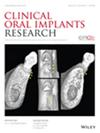间充质干细胞合成骨替代物用于萎缩牙槽嵴骨增强:一项随机对照临床试验
IF 5.3
1区 医学
Q1 DENTISTRY, ORAL SURGERY & MEDICINE
引用次数: 0
摘要
目的评价基于细胞的三维骨增强治疗重度牙槽骨缺损的有效性和安全性。材料和方法一项2期随机对照临床试验评估了细胞疗法的安全性和有效性,该疗法将自体髂骨源性间充质细胞植入覆盖有不可吸收膜的合成生物可吸收骨替代物上。对照组采用自体骨块移植。5个月后,比较CBCT扫描来测量再生手术后骨体积的变化。随后,在再生区域放置牙种植体。结果共纳入48例患者,随机分组,其中试验组36例,对照组12例。然而,7名患者没有达到所需的最小增殖MSCs数量,因此无法接受治疗。经测试的干预显示骨体积显著增加,平均差异为480.01 mm3 (p = 0.032)。同样,试验组从基线到5个月的平均骨嵴体积变化(1066.91 mm3)明显高于对照组(586.9 mm3)。两组患者的不良反应和发病率均较轻。在再生骨上放置种植体,两组均成功整合。结论与对照治疗相比,细胞为基础的治疗导致骨体积的显著变化,所有患者都可以种植牙。该手术与最小的不良反应和患者发病率相关。临床试验注册网站:NCT03373052, NCT04297813本文章由计算机程序翻译,如有差异,请以英文原文为准。
Bone Augmentation of Atrophic Alveolar Ridges Using a Synthetic Bone Substitute With Mesenchymal Stem Cells: A Randomized, Controlled Clinical Trial
ObjectivesTo assess the efficacy and safety of a cell‐based therapy for 3D bone augmentation of severe alveolar bone defects prior to dental implant placement.Materials and MethodsA Phase 2 randomized controlled clinical trial evaluated the safety and efficacy of a cell therapy using expanded autologous iliac crest‐derived mesenchymal cells seeded on a synthetic bioabsorbable bone substitute covered with a non‐resorbable membrane. The control group received an autogenous bone block graft. After 5 months, CBCT scans were compared to measure the bone volume changes achieved after the regenerative surgery. Subsequently, dental implants were placed in the regenerated areas.ResultsA total of 48 patients were included and randomized (36 patients in the test group and 12 in the control group). However, seven patients did not reach the minimum required number of expanded MSCs and were therefore unable to be treated. The tested intervention demonstrated significantly greater gains in bone volume, with a mean difference of 480.01 mm3 (p = 0.032). Similarly, the mean change in bone crest volume from baseline to 5 months was notably higher in the test group (1066.91 mm3 ) compared to the control group (586.9 mm3 ). Adverse reactions and patient morbidity were minor in both groups. Implants were placed on the regenerated bone, and all were integrated successfully in both groups.ConclusionsThe cell‐based therapy resulted in significant changes in bone volume compared to the control treatment, enabling dental implants in all patients. The procedure was associated with minimal adverse effects and patient morbidity.Trial RegistrationClinicalTrials.gov : NCT03373052, NCT04297813
求助全文
通过发布文献求助,成功后即可免费获取论文全文。
去求助
来源期刊

Clinical Oral Implants Research
医学-工程:生物医学
CiteScore
7.70
自引率
11.60%
发文量
149
审稿时长
3 months
期刊介绍:
Clinical Oral Implants Research conveys scientific progress in the field of implant dentistry and its related areas to clinicians, teachers and researchers concerned with the application of this information for the benefit of patients in need of oral implants. The journal addresses itself to clinicians, general practitioners, periodontists, oral and maxillofacial surgeons and prosthodontists, as well as to teachers, academicians and scholars involved in the education of professionals and in the scientific promotion of the field of implant dentistry.
 求助内容:
求助内容: 应助结果提醒方式:
应助结果提醒方式:


